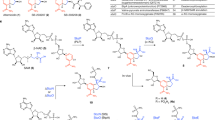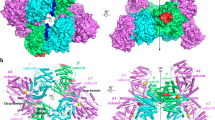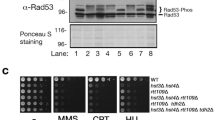Abstract
X-RAY crystallographic studies have indicated that four dehydrogenases1–4, including lactate1 and glyceraldehyde phosphate4 dehydrogenase, contain a central parallel β sheet consisting of six strands flanked by four α helices. This super-secondary structure5 is called the dinucleotide fold or nicotinamide adenine dinucleotide (NAD) domain since it forms an NAD-binding site at the C terminus of the β sheet. The dinucleotide fold can be considered as two roughly identical mononucleotide domains each containing about 60 residues arranged in an alternating βαβαβ sequence and related by an approximate twofold axis5. The aromatic specificity site of subtilisin6,7 and the flavin-binding site of flavodoxin8,9 seem5 to be formed by a secondary structure very similar to a mononucleotide domain of the dehydrogenases. Crystallographic studies have shown that the structures of phosphoglycerate kinase10,11, hexokinase12, adenylate kinase13, phosphoglycerate mutase14 and triosephosphate isomerase15 also contain β sheets containing at least five strands flanked by at least three α helices. The nucleoside phosphate or, in the case of the mutase and isomerase, the sugar phosphate-binding site for each of these enzymes is either known10–12, or strongly suspected13–15 to be located at the C terminus of the β sheet. Differences occur, however, in some of these supersecondary structures relative to the NAD domain of the dehydrogenase family as regards the direction of the β strands12, the location of the binding site relative to the plane of the β sheet12, and most significantly, the sequential order or connectivity of the individual strands in the β sheet12–14. Whether these related supersecondary structures represent convergent5,12 or divergent evolutionary processes4,16, or both17, is a topic of active debate.
This is a preview of subscription content, access via your institution
Access options
Subscribe to this journal
Receive 51 print issues and online access
$199.00 per year
only $3.90 per issue
Buy this article
- Purchase on SpringerLink
- Instant access to full article PDF
Prices may be subject to local taxes which are calculated during checkout
Similar content being viewed by others
References
Adams, M. J., et al., Nature, 227, 1098–1103 (1970).
Hill, E., Tsernoglou, D., Webb, L., and Banaszak, L. J., J. molec. Biol., 72, 577–589 (1972).
Bränden, C. I., et al., Proc. natn. Acad. Sci. U.S.A., 70, 2439–2442 (1973).
Buehner, M., Ford, G. C., Moras, D., Olsen, K. W., and Rossmann, M. G., Proc. natn. Acad. Sci. U.S.A., 70, 3052–3054 (1973).
Rao, S. T., and Rossmann, M. G., J. molec. Biol., 76, 241–256 (1973).
Wright, C. S., Alden, R. A., and Kraut, J., Nature, 221, 235–242 (1969).
Drenth, J., Hol, W. G. J., Jansonius, J. N., and Koekoek, R., Cold Spring Harb. Symp. quant. Biol., 36, 107–116 (1971).
Watenpaugh, K. D., Sicker, L. C., Jensen, L. H., LeGall, T., and Dubourdieu, M., Proc. natn. Acad. Sci. U.S.A., 69, 3185–3188 (1972).
Andersen, R. D., et al., Proc. natn. Acad. Sci., U.S.A., 69, 3189–3191 (1972).
Bryant, T. N., Watson, H. C., and Wendell, P. L., Nature, 247, 14–17 (1974).
Blake, C. C. F., and Evans, P. R., J. molec. Biol., 84, 585–601 (1974).
Fletterick, R. J., Bates, D. J., and Steitz, T. A., Proc. natn. Acad. Sci. U.S.A., 72, 38–42 (1975).
Schulz, G. E., Elzinga, M., Marx, F., and Schirmer, R. H., Nature, 250, 120–123 (1974).
Campbell, J. W., Watson, H. C., and Hodgson, G. I., Nature, 250, 301–303 (1974).
Banner, D. W., et al., Nature, 255, 609–614 (1975).
Rossman, M. G., Moras, D., and Olsen, K. W., Nature, 250, 194–199 (1974).
Schulz, G. E., and Schirmer, R. H., Nature, 250, 142–144 (1974).
Thompson, S. T., Cass, K. H., and Stellwagen, E., Proc. natn. Acad. Sci. U.S.A., 72, 669–672 (1975).
Thompson, S. T., and Stellwagen, E., Proc. natn. Acad. Sci. U.S.A., (in the press).
Author information
Authors and Affiliations
Rights and permissions
About this article
Cite this article
STELLWAGEN, E., CASS, R., THOMPSON, S. et al. Predicted distribution of NAD domain among glycolytic enzymes. Nature 257, 716–718 (1975). https://doi.org/10.1038/257716a0
Received:
Accepted:
Issue date:
DOI: https://doi.org/10.1038/257716a0



